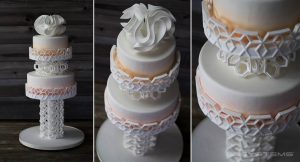By Crystal Tatis
It’s a beautiful day to be hungry, because the time has come to PRINT your food! Yes, I know you have questions…
3-D printers have become a progressively common tool in various industries like medicine, robotics, aerospace engineering and now, food. How does printing your food work? How 3D printing food works is very much like a regular 3D printer, in the sense that material is released through a print head onto a surface). A dish can be printed in any shape the designer wants, within some spacial limitations. Your soon-to-be printed food does not come in the traditional packaging that plastic comes in for 3D printing. Your ingredients need to have a certain degree of viscosity and must therefore be inserted into a syringe-like container to be extruded. Does the 3D food printer actually cook the food? Most methods don’t cook the food automatically. How it works is that if you’re printing a pizza, the printer will extrude the dough and tomato sauce, but won’t cook it. You would have to manually put the pizza in the oven for it to cook. However, the PancakeBot™ releases the batter directly onto the hotplate or griddle. This process isn’t automatic either, because you still have to manually flip the pancake.
Can I only do two or three dishes? No, as long as the ingredients are puréed, you can print as many different dishes you can imagine. This includes vegetables, fruits, various kinds of dough and candy. Is it safe? You do not have to worry because this type of food is safe to eat, because 3D printed food is nothing more than fresh, natural ingredients that are being processed in different a way, this way allows it to be released through a nozzle onto a food-safe surface. How long does it take? The actual time it takes fluctuates on the type of ingredients, design and the features on your 3D printer, because it does take some time to process, for example, a pancake can take up to 4 minutes and a detailed chocolate figure can be up to 20 minutes.
Are there restaurants that use this? Yes, it is already being used in culinary institutes and gourmet restaurants, as well as kitchens that are creating meals suitable for seniors. For example, The Food Ink. is a conceptual “pop up” gourmet experience in which everything is 3D printed, from the utensils, furniture and food. Also, the German company Biozoon Food Innovations dedicates its time to create meals that will be more delightful for seniors to eat. The company uses fresh ingredients like chicken or vegetables, makes them into a paste and then prints them onto a surface in the shape of the used ingredient: for example a carrot and it’s being used by over one thousand senior citizen homes in Germany.
WHAT 3D PRINTERS ARE THERE?
- ChefJet (For Professionals)
3D Systems has created a 3D food printer called the ChefJet which creates very complex and delicate figures out of fine granulated sugar or chocolate. These can be used as a cake topper or garnishes on a dish. The results are very cool geometric objects that look like art and taste delicious.

- PancakeBot (For Consumers)
PancakeBot™ was created by Miguel Valenzuela, after he built a “Pancake Machine” out of LEGO® for his two daughters. The PancakeBot™ was first showcased at the World Maker Faire in New York. At last, in 2004 Miguel displayed an acrylic version of the PancakeBot™ at both the San Mateo and White House Maker Faire. After a positive response, Miguel partnered with StoreBound to bring a polished version of the product to the market. Currently, bringing the PancakeBot™ to kitchens everywhere. Sells for $299.00
- Foodini ( For Consumers)
The Foodini was introduced to the market on 2014, it takes prepared ingredients and makes the process of preparing a home cooked meal that has not been heavily processed smooth. So you can buy your ingredients at your favorite store and the Foodini will come with empty stainless steel capsules that you can then fill with your own ingredients. This product is now in production and is only available to select customers, focusing on professional kitchen users. The price of this food printer is anticipated to be around $2,000.
- Focus (For Consumers)
The Focus from byFlow is a portable 3D printer that comes with interchangeable 3D printing heads. The food 3D printer is set up in 20 seconds and all ready to print in 2 minutes. Aside from the familiar plastics such as ABS, PLA and nylon, it can also print with wood, bronze, glass, clay and silicon. The price of this food printer is currently at $3,156.69 which includes The Focus 3D Printer, Paste print head, Paste syringe, High accuracy nozzle, 300g of ceramic powder, Quick Start Guide and 12 months carry-in warranty.
WHAT’S NEXT?
Mark Post is the leader of a research group at Maastricht University in the Netherlands and he wants to bring the first 3D printed meat. His team has managed to grow a hamburger patty using stem cells taken from a cow. This takes a very intricate process where the layers of beef are grown in a petri dish and minced into a patty at the end. This could bring many benefits, environmentally speaking, because this would result in 96% reduction in greenhouse gas emissions compared to rearing animals, this uses 45% of the energy, 1% of the land and 4% of the water associated with conventional beef production. Currently, the patty costs about $310,500 to cultivate. The research team estimates the product will be available by 2020.
To see a video of how the Pancakebot™ works its magic, click here.
For more delicate powder food creations with the ChefJet, click here
